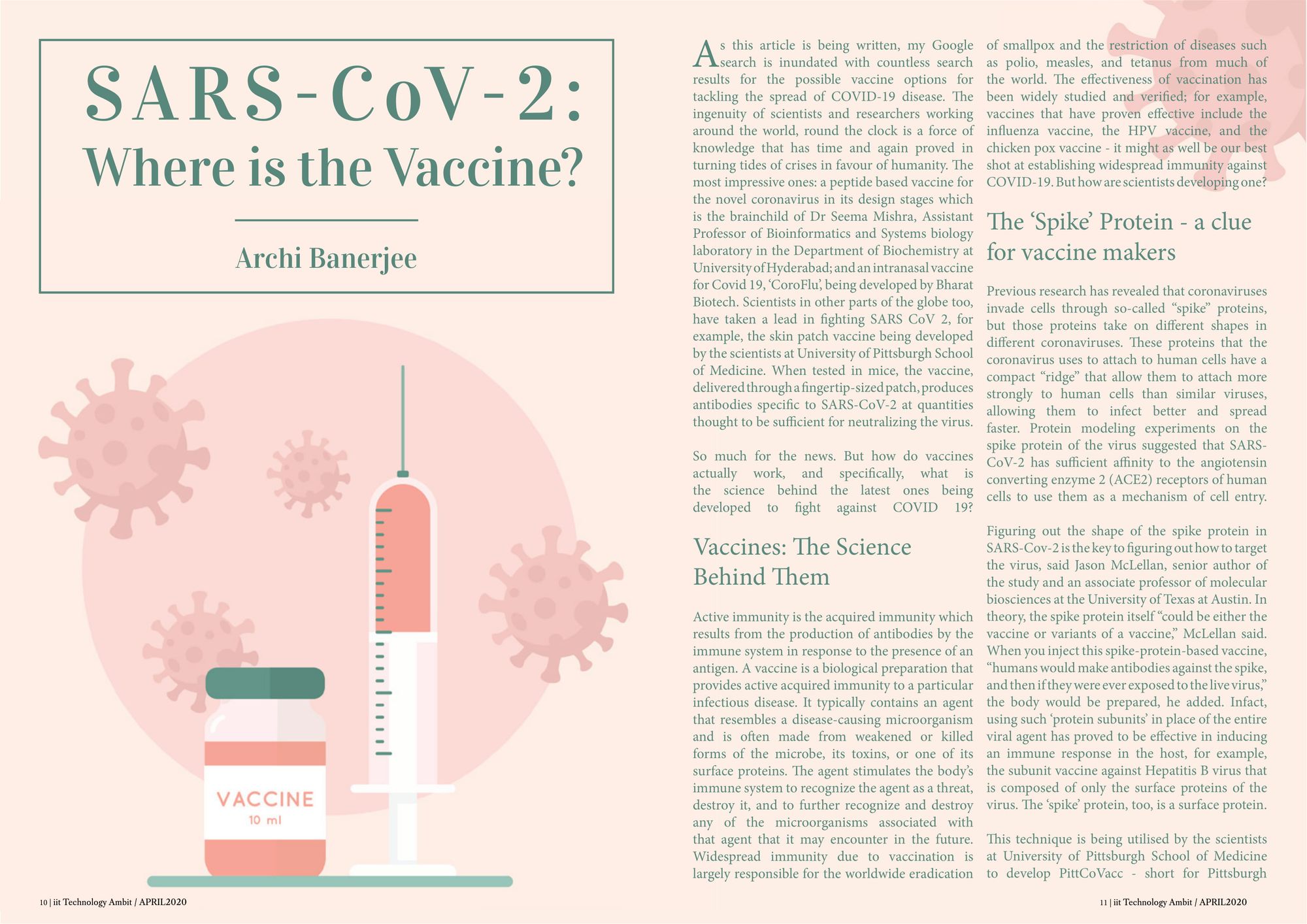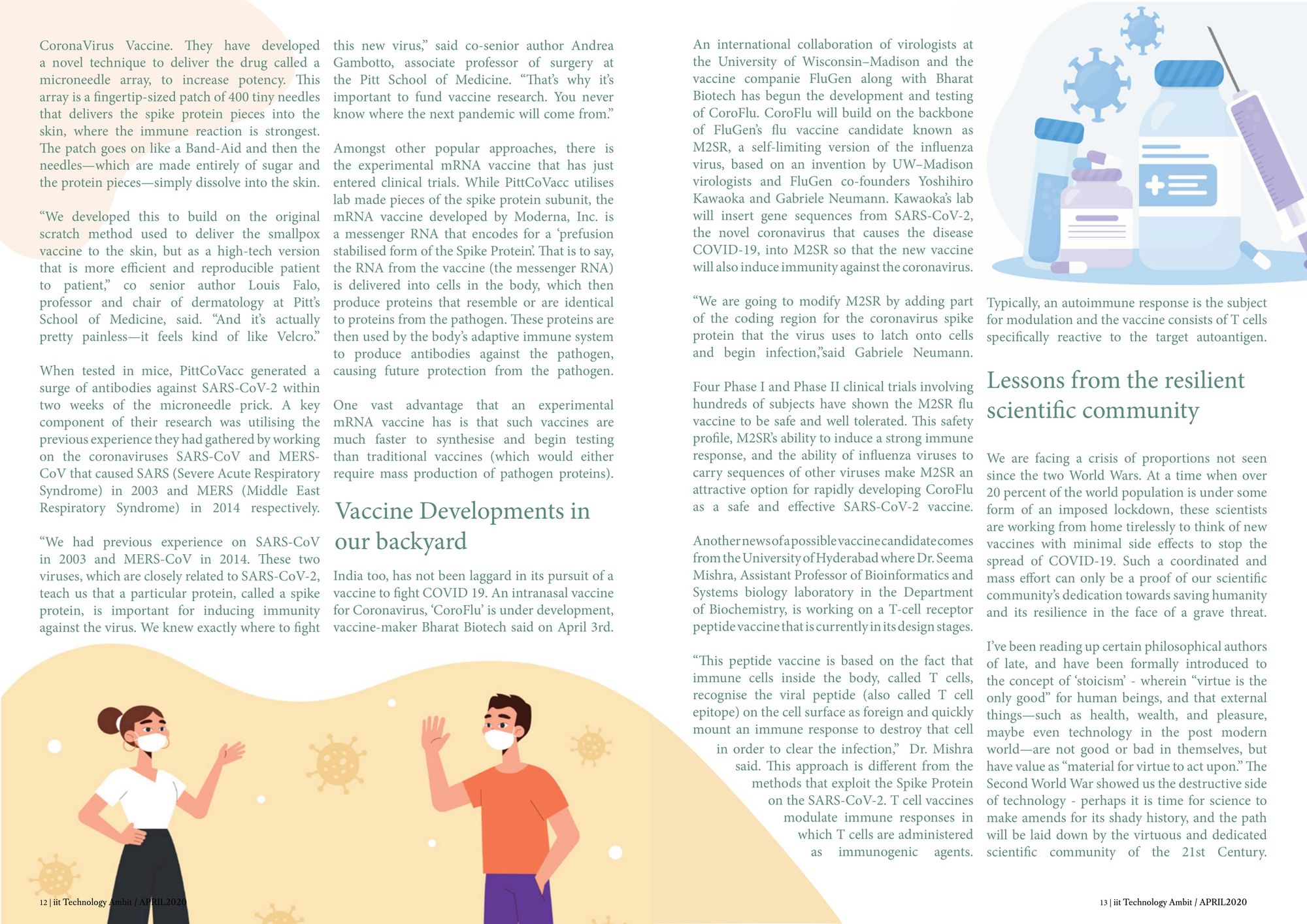As this article is being written, my Google Search is inundated with countless search results for the possible vaccine options for tackling the spread of COVID-19 disease.
The ingenuity of scientists and researchers working around the world, round the clock is a force of knowledge that has time and again proved in turning tides of crises in favour of humanity. The most impressive ones: a peptide based vaccine for the novel coronavirus in its design stages which is the brainchild of Dr Seema Mishra, Assistant Professor of Bioinformatics and Systems biology laboratory in the Department of Biochemistry at University of Hyderabad; and an intranasal vaccine for Covid 19, ‘CoroFlu’, being developed by Bharat Biotech.
Scientists in other parts of the globe too, have taken a lead in fighting SARS CoV 2, for example, the skin patch vaccine being developed by the scientists at University of Pittsburgh School of Medicine. When tested in mice, the vaccine, delivered through a fingertip-sized patch, produces antibodies specific to SARS-CoV-2 at quantities thought to be sufficient for neutralizing the virus.
So much for the news. But how do vaccines actually work, and specifically, what is the science behind the latest ones being developed to fight against COVID 19?
Vaccines: The Science Behind Them
Active immunity is the acquired immunity which results from the production of antibodies by the immune system in response to the presence of an antigen.
A vaccine is a biological preparation that provides active acquired immunity to a particular infectious disease. It typically contains an agent that resembles a disease-causing microorganism and is often made from weakened or killed forms of the microbe, its toxins, or one of its surface proteins. The agent stimulates the body's immune system to recognize the agent as a threat, destroy it, and to further recognize and destroy any of the microorganisms associated with that agent that it may encounter in the future.
Widespread immunity due to vaccination is largely responsible for the worldwide eradication of smallpox and the restriction of diseases such as polio, measles, and tetanus from much of the world. The effectiveness of vaccination has been widely studied and verified; for example, vaccines that have proven effective include the influenza vaccine, the HPV vaccine, and the chicken pox vaccine - it might as well be our best shot at establishing widespread immunity against COVID-19. But how are scientists developing one?
The ‘Spike’ Protein - a clue for vaccine makers
Previous research has revealed that coronaviruses invade cells through so-called "spike" proteins, but those proteins take on different shapes in different coronaviruses. These proteins that the coronavirus uses to attach to human cells have a compact "ridge" that allow them to attach more strongly to human cells than similar viruses, allowing them to infect better and spread faster.

Protein modeling experiments on the spike protein of the virus suggested that SARS-CoV-2 has sufficient affinity to the angiotensin converting enzyme 2 (ACE2) receptors of human cells to use them as a mechanism of cell entry.
Figuring out the shape of the spike protein in SARS-Cov-2 is the key to figuring out how to target the virus, said Jason McLellan, senior author of the study and an associate professor of molecular biosciences at the University of Texas at Austin. In theory, the spike protein itself "could be either the vaccine or variants of a vaccine," McLellan said.
When you inject this spike-protein-based vaccine, "humans would make antibodies against the spike, and then if they were ever exposed to the live virus," the body would be prepared, he added. Infact, using such ‘protein subunits’ in place of the entire viral agent has proved to be effective in inducing an immune response in the host, for example, the subunit vaccine against Hepatitis B virus that is composed of only the surface proteins of the virus. The ‘spike’ protein, too, is a surface protein.
This technique is being utilised by the scientists at University of Pittsburgh School of Medicine to develop PittCoVacc - short for Pittsburgh CoronaVirus Vaccine. They have developed a novel technique to deliver the drug called a microneedle array, to increase potency. This array is a fingertip-sized patch of 400 tiny needles that delivers the spike protein pieces into the skin, where the immune reaction is strongest. The patch goes on like a Band-Aid and then the needles—which are made entirely of sugar and the protein pieces—simply dissolve into the skin.
“We developed this to build on the original scratch method used to deliver the smallpox vaccine to the skin, but as a high-tech version that is more efficient and reproducible patient to patient,” co senior author Louis Falo, professor and chair of dermatology at Pitt’s School of Medicine, said. “And it’s actually pretty painless—it feels kind of like Velcro.”
When tested in mice, PittCoVacc generated a surge of antibodies against SARS-CoV-2 within two weeks of the microneedle prick. A key component of their research was utilising the previous experience they had gathered by working on the coronaviruses SARS-CoV and MERS-CoV that caused SARS (Severe Acute Respiratory Syndrome) in 2003 and MERS (Middle East Respiratory Syndrome) in 2014 respectively.
“We had previous experience on SARS-CoV in 2003 and MERS-CoV in 2014. These two viruses, which are closely related to SARS-CoV-2, teach us that a particular protein, called a spike protein, is important for inducing immunity against the virus. We knew exactly where to fight this new virus,” said co-senior author Andrea Gambotto, associate professor of surgery at the Pitt School of Medicine. “That’s why it’s important to fund vaccine research. You never know where the next pandemic will come from.”
Amongst other popular approaches, there is the experimental mRNA vaccine that has just entered clinical trials. While PittCoVacc utilises lab made pieces of the spike protein subunit, the mRNA vaccine developed by Moderna, Inc. is a messenger RNA that encodes for a ‘prefusion stabilised form of the Spike Protein’.
That is to say, the RNA from the vaccine (the messenger RNA) is delivered into cells in the body, which then produce proteins that resemble or are identical to proteins from the pathogen. These proteins are then used by the body's adaptive immune system to produce antibodies against the pathogen, causing future protection from the pathogen.
One vast advantage that an experimental mRNA vaccine has is that such vaccines are much faster to synthesise and begin testing than traditional vaccines (which would either require mass production of pathogen proteins).
Vaccine Developments in our backyard
India too, has not been laggard in its pursuit of a vaccine to fight COVID 19. An intranasal vaccine for Coronavirus, ‘CoroFlu’ is under development, vaccine-maker Bharat Biotech said on April 3rd. An international collaboration of virologists at the University of Wisconsin–Madison and the vaccine companie FluGen along with Bharat Biotech has begun the development and testing of CoroFlu.
CoroFlu will build on the backbone of FluGen's flu vaccine candidate known as M2SR, a self-limiting version of the influenza virus, based on an invention by UW–Madison virologists and FluGen co-founders Yoshihiro Kawaoka and Gabriele Neumann. Kawaoka’s lab will insert gene sequences from SARS-CoV-2, the novel coronavirus that causes the disease COVID-19, into M2SR so that the new vaccine will also induce immunity against the coronavirus.
“We are going to modify M2SR by adding part of the coding region for the coronavirus spike protein that the virus uses to latch onto cells and begin infection,”said Gabriele Neumann.
Four Phase I and Phase II clinical trials involving hundreds of subjects have shown the M2SR flu vaccine to be safe and well tolerated. This safety profile, M2SR’s ability to induce a strong immune response, and the ability of influenza viruses to carry sequences of other viruses make M2SR an attractive option for rapidly developing CoroFlu as a safe and effective SARS-CoV-2 vaccine.
Another news of a possible vaccine candidate comes from the University of Hyderabad where Dr. Seema Mishra, Assistant Professor of Bioinformatics and Systems biology laboratory in the Department of Biochemistry, is working on a T-cell receptor peptide vaccine that is currently in its design stages.
“This peptide vaccine is based on the fact that immune cells inside the body, called T cells, recognise the viral peptide (also called T cell epitope) on the cell surface as foreign and quickly mount an immune response to destroy that cell in order to clear the infection,” Dr. Mishra said.

This approach is different from the methods that exploit the Spike Protein on the SARS-CoV-2. T cell vaccines modulate immune responses in which T cells are administered as immunogenic agents. Typically, an autoimmune response is the subject for modulation and the vaccine consists of T cells specifically reactive to the target autoantigen.
Lessons from the resilient scientific community
We are facing a crisis of proportions not seen since the two World Wars. At a time when over 20 percent of the world population is under some form of an imposed lockdown, these scientists are working from home tirelessly to think of new vaccines with minimal side effects to stop the spread of COVID-19. Such a coordinated and mass effort can only be a proof of our scientific community’s dedication towards saving humanity and its resilience in the face of a grave threat.
I’ve been reading up certain philosophical authors of late, and have been formally introduced to the concept of ‘stoicism’ - wherein "virtue is the only good" for human beings, and that external things—such as health, wealth, and pleasure, maybe even technology in the post modern world—are not good or bad in themselves, but have value as "material for virtue to act upon.”
The Second World War showed us the destructive side of technology - perhaps it is time for science to make amends for its shady history, and the path will be laid down by the virtuous and dedicated scientific community of the 21st Century.


